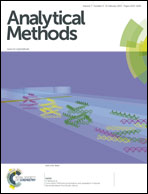Role of electrostatic contributions in the separation of peptides with silica hydride stationary phases†
Abstract
In this study a general analytical approach has been investigated with a focus on elucidating the impact of the free energy of electrostatic interactions associated with peptide retention with silica hydride stationary phases. In particular, the contributions from electrostatic interactions between peptides and the stationary phase in the presence of water-organic mobile phases of varying organic modifier content, and containing different percentages of formic or acetic acid, were assessed using a 4 μm silica hydride adsorbent (the Diamond Hydride™ phase) in capillary chromatographic format. The magnitudes of the electrostatic contributions were calculated from the effective peptide charge and the measured zeta potential values of the stationary phase as a function of mobile phase compositions. These studies revealed that in acidic mobile phases, and depending on the peptide structure, a significant proportion of the change in the overall free energy associated with peptide retention with the Diamond Hydride™ phase can be attributed to attractive electrostatic interactions. Multi-parametric relationships have been elaborated to include the electrostatic contribution in these retention-free energy dependencies. The general application of the presented analytical methods is expected to significantly broaden the application potential and the interpretation of the retention behaviour of peptides and other compound classes separated with silica hydride and related types of silica-based stationary phases.


 Please wait while we load your content...
Please wait while we load your content...